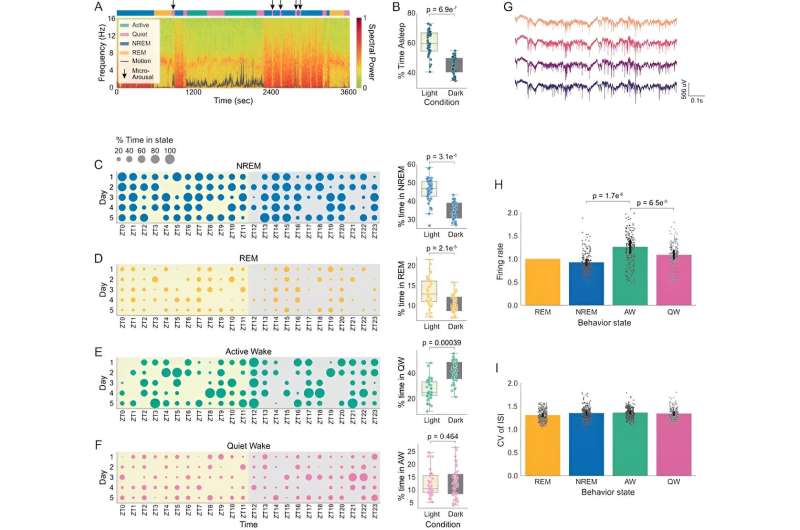This article has been reviewed according to Science X's editorial process and policies. Editors have highlighted the following attributes while ensuring the content's credibility:
fact-checked
peer-reviewed publication
trusted source
proofread
Why do we sleep? Researchers propose an answer to this age-old question

Sleep is a fundamental need, just like food or water. "You'll die without it," said Keith Hengen, an assistant professor of biology at Washington University in St. Louis. But what does sleep actually accomplish? For years, the best researchers could say is that sleep reduces sleepiness—hardly a satisfying explanation for a basic requirement of life.
But by melding concepts from the fields of physics and biology, Hengen and a team of Arts & Sciences researchers have constructed a theory that could explain both the meaning of sleep and the complexity of the brain. As reported in a new study published in Nature Neuroscience, they tracked the brain activity of sleeping rats to make the case that the brain needs to regularly reset its operating system to reach "criticality," a state that optimizes thinking and processing.
"The brain is like a biological computer," Hengen said. "Memory and experience during waking change the code bit by bit, slowly pulling the larger system away from an ideal state. The central purpose of sleep is to restore an optimal computational state."
Co-authors of the paper include Ralf Wessel, a professor of physics; Yifan Xu, a graduate student in biology studying neuroscience; and Aidan Schneider, a graduate student in the Computational & Systems Biology program, all in Arts & Sciences.
Wessel said physicists have been thinking about criticality for more than 30 years, but they never dreamed the work would affect sleep. In the world of physics, criticality describes a complex system that exists at the tipping point between order and chaos. "At one extreme, everything is completely regular. At the other extreme, everything is random," Wessel said.
Criticality maximizes the encoding and processing of information, making it an attractive candidate for a general principle of neurobiology. In a 2019 study, Hengen and Wessel established that the brain actively works to maintain criticality.
In the new paper, the team provides the first direct evidence that sleep restores the computational power of the brain. It's a radical departure from the long-held assumption that sleep must somehow replenish mysterious and unknown chemicals depleted during waking hours.
After their 2019 paper, Hengen and Wessel theorized that learning, thinking, and being awake must push the brain away from criticality and that sleep is perfectly positioned to reset the system. "We realized this would be a really cool and intuitive explanation for the core purpose of sleep," Hengen said. "Sleep is a systems-level solution to a systems-level problem."
Brain cascades
To test their theory on the role of criticality in sleep, the researchers tracked the spiking of many neurons in the brains of young rats as they went about their normal sleeping and waking routines. "You can follow these little cascades of activity through the neural network," Hengen said.
He said these cascades, also called neural avalanches, reflect how information flows through the brain. "At criticality, avalanches of all sizes and durations can occur. Away from criticality, the system becomes biased toward only small avalanches or only large avalanches. This is analogous to writing a book and only being able to use short or long words."
As predicted, avalanches of all sizes occurred in the rats that had just woken up from restorative sleep. Across the course of waking, the cascades started to shift toward smaller and smaller sizes. The researchers found they could predict when rats were about to go to sleep or wake up by tracking the distribution of avalanches. When cascade sizes were reduced to a certain point, sleep wasn't far away.
"The results suggest that every waking moment pushes relevant brain circuits away from criticality, and sleep helps the brain reset," Hengen said.
Physics meets biology
When physicists first developed the concept of criticality in the late 1980s, they were looking at piles of sand on a checkerboard-like grid, a scenario seemingly far removed from brains.
But those sand piles provided an important insight, Wessel said. If thousands of grains are dropped on the grid following simple rules, the piles quickly reach a critical state where interesting things start happening. Large and small Avalanches can start without warning, and piles in one square start spilling into the others. "The whole system organizes itself into something extremely complex," he said.
Wessel said that the neural avalanches taking place in the brain are much like the avalanches of sand on a grid. In each case, the cascades are the hallmark of a system that has reached its most complex state.
According to Hengen, every neuron is like an individual grain of sand following very basic rules. Neurons are essentially on/off switches that decide whether or not to fire based on straightforward inputs. If billions of neurons can reach criticality—the sweet spot between too much order and too much chaos—they can work together to form something complex and wondrous. "Criticality maximizes a bunch of features that sound very desirable for a brain," Hengen said.
The new study was a multidisciplinary effort. Hengen, Xu, and Schneider designed the experiments and provided the data, while Wessel joined the team to implement the mathematical equations necessary to understand sleep in the framework of criticality. "It's a beautiful collaboration between physics and biology," Wessel said.
More information: Yifan Xu et al, Sleep restores an optimal computational regime in cortical networks, Nature Neuroscience (2024). DOI: 10.1038/s41593-023-01536-9





















